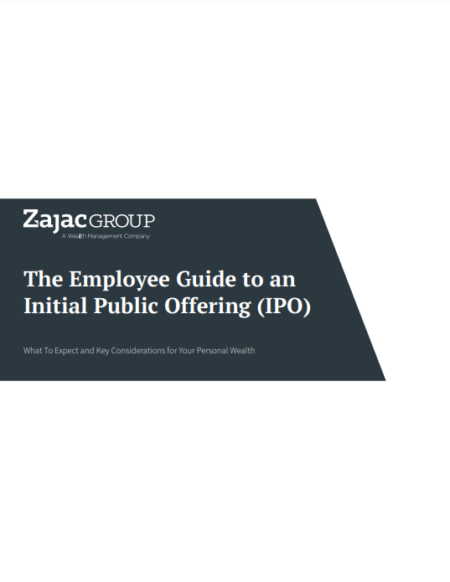 Access to an employee stock purchase plan that offers a lookback provision and a discount is often a great benefit for employees. If you can afford to contribute, these two features may allow you to benefit from an increasing stock price while potentially receiving downside protection (assuming you sell your shares immediately after they are purchased).
Access to an employee stock purchase plan that offers a lookback provision and a discount is often a great benefit for employees. If you can afford to contribute, these two features may allow you to benefit from an increasing stock price while potentially receiving downside protection (assuming you sell your shares immediately after they are purchased).
If you work for a company that recently went through an initial public offering, or IPO, an employee stock purchase plan, or ESPP, might be a newly-offered benefit from your employer. If it is, you may be wondering if it makes sense to participate.
To help you evaluate, here is a primer on how an ESPP works, what you need to know about your plan, and why it may or may not make sense for your financial planning goals and objectives.
An Employee Stock Purchase Plan If Your Company Just Went Through an IPO
Generally speaking, an employee stock purchase plan allows you to purchase shares of your company stock via convenient payroll deductions. In addition to offering a convenient way to buy shares, an ESPP may also provide the following benefits:
- Some ESPPs give you the ability to purchase shares of company stock at a discounted price. For qualified plans, the discount can be up to 15% off the purchase price of the stock.
- Some ESPPs offer a “lookback provision” that lets you buy the stock at the grant date price or the purchase date price, whichever is lower (and therefore less expensive to you).
Your plan document will provide you with all the details on how the particular ESPP your company offers works, including its rules and any limitations. When you review this document, you’ll want to identify and understand the following features of your ESPP:
- What the offering period is, which can be up to 27 months long in qualified plans.
- How to enroll and how much you can contribute to the plan, which is often based on a $25,000 calendar year limit for a qualified ESPP.
- The deals on the purchase periods, which occur within an offering period (and there may be several within a single offering period).
- What the taxability of your employee stock purchase plan is, which depends on whether or not you do a qualifying or disqualifying disposition (but more on that later).
This is an extremely concise rundown of ESPPs and some important terms. Everyone with access to an employee stock purchase plan should be familiar with these basics — but if your ESPP is a new benefit coming from a company that went through a recent IPO, you also need to understand how that event can impact your plan.
Free Guide to IPOs
If you’re an executive, director, or other critical employee whose company is in the throes of an initial public offering (IPO), you’ll want to read this.
Download Now
How a Recent IPO Can Impact Your Employee Stock Purchase Plan
When a company goes through an initial public offering, they begin to sell shares of stock to the public. As a shareholder, going public means that you can sell your shares on a public exchange (although you should still check with your company to see if any restrictions apply to shares you own).
Public companies regularly trade, so it is easy to know what your stock is worth. That can make it easier to make a plan for what to do with the proceeds if you turn your company stock into cash that can be used for other needs or to achieve financial goals.
The price at which your company goes public is known as the public offering price. This price, as it relates to an ESPP, is important because it might be the grant date price that is used at the start of an offering period.
This is one price at which you might be able to buy shares of stock in the ESPP for the duration of the offering period. The exact price you pay to purchase shares will be determined by the future stock price and by the rules of your plan.
Regardless, however, of those future price points, participating in your ESPP immediately following an IPO can be a smart strategy. Let’s take a look at why and how this may be true by exploring several potential scenarios.
For the following examples, we’ll assume the following:
- There are four purchase periods during the offering period.
- You receive a 15% discount on the purchase price of the stock.
- The grant date price is $20 per share.
- You can purchase 625 shares on each purchase date.
Now, let’s explore three separate examples to illustrate outcomes in an up market, a flat market, and a down market to see the potential benefits and drawbacks of participating in an ESPP that coincides with an IPO.
ESPP Example 1: The Stock Price Goes Up Consistently (Up Market)
In this example, we will assume that the company stock price doubles each purchase period. As the price goes up through the duration of the offering period, the lookback provision of the ESPP allows ESPP participants the privilege of purchasing shares at the $20 grant price.
You can purchase at the $20 price when the actual purchase date price is $400, which is significant — and immediate profit should you turn around and sell as soon as you buy. On top of that, your actual cost would be just $17 per share, thanks to the 15% discount benefit.
| Grant Price | Purchase Date Price | Actual Purchase Price | Shares Purchased | Total Cost | Total Value (When Sold Immediately After Purchase) |
| $20.00 | $50.00 | $17.00 | 625 | $10,625.00 | $31,250.00 |
| $20.00 | $100.00 | $17.00 | 625 | $10,625.00 | $62,500.00 |
| $20.00 | $200.00 | $17.00 | 625 | $10,625.00 | $125,000.00 |
| $20.00 | $400.00 | $17.00 | 625 | $10,625.00 | $250,000.00 |
| 2500 | $42,500.00 | $468,750.00 |
On each of the four purchase dates, 625 shares are purchased at the lookback and discounted price of $17 per share, or $10,625 total in each period. The actual stock price at the various times of purchase ranges from $50 in purchase period 1 to $400 in purchase period 4.
Once the shares are purchased, you, as the ESPP participant, can elect to keep or sell them. If we assume that you sell immediately after purchase, then your total proceeds equal $468,750, your total cost is $42,500, and your total pre-tax profit over four purchase periods is $426,250.
If, on the other hand, you decided to wait until the end of the offering period to sell all 2,500 shares at the final purchase date when the share price was $400, the total proceeds would be $1,000,000. That would give you a pre-tax profit of $957,500!
In this example, you not only benefit from an increasing stock price, but you could also benefit from a tax standpoint if you bought and held some of your shares for over a year. Some portion of the shares you eventually sold at the last date could meet the rules for a qualifying disposition and therefore, could receive a more favorable tax rate.
The flipside is that the longer you maintain ownership of shares of stock, the longer you expose yourself to the regular investment risks of holding a single stock position. This may leave you subject to significant price volatility, and this risk may or may not be one you can afford to take.
ESPP Example 2: The Stock Price Stays the Same (Flat Market)
An employee stock purchase plan can drive a significant increase in your wealth if your company stock price goes up while you participate. However, not all stock prices go up after an IPO, and it makes sense to compare that potential scenario to an alternative possibility.
Let’s assume that, instead of the stock price going up, the IPO is priced at $20. The shares “pop” on the first day to $50 per share, but then stay fixed at that price throughout four purchase periods.
| Grant Price | Purchase Date Price | Actual Purchase Price | Shares Purchased | Total Cost | Total Value (When Sold Immediately After Purchase) |
| $20.00 | $50.00 | $17.00 | 625 | $10,625.00 | $31,250.00 |
| $20.00 | $50.00 | $17.00 | 625 | $10,625.00 | $31,250.00 |
| $20.00 | $50.00 | $17.00 | 625 | $10,625.00 | $31,250.00 |
| $20.00 | $50.00 | $17.00 | 625 | $10,625.00 | $31,250.00 |
| 2500 | $42,500.00 | $125,000.00 |
Just as in the first example, you can purchase shares of your company stock at the grant date price of $17 thanks to a lookback provision and discount.
Over four purchase periods, the same 2,500 total shares will be purchased for the same total cost of $42,500. If we assume the stock price stays fixed at $50 per share and that you sell the shares immediately after purchase, the total proceeds will be $125,000, and your overall profit will be $82,500.
This might not be quite as impressive as the profit gained in a scenario where the stock price only goes up — but it’s still a meaningful increase in wealth.
Because we’re assuming things stay flat here, your profit would still be $82,500 even if you held on to all shares throughout all purchase periods and then sold everything at the end. But, some of the shares may still be sold as qualifying shares and therefore, could get the same preferential tax treatment as discussed above.
In this case, the after-tax outcome of a qualifying disposition could net you a more than selling shares as they’re purchased.
ESPP Example 3: The Stock Price Goes Down (Down Market)
Everyone hopes that the stock price of the shares they own goes up. But that doesn’t always happen, and there’s nothing that says the shares you buy through your ESPP can’t drop in value.
While this may mean that much (or all) of the profit shown in the previous two examples would not show up in this scenario, an ESPP with a lookback and a discount may still protect you from the downside risk of declining share prices.
That means that, despite a down market, maximum participation in your ESPP might still be a good idea. This example shows us how, and in it, we’ll assume the company stock IPOs at $20 per share but then drops each purchase date, with the last purchase date price at just $2.50.
| Grant Price | Purchase Date Price | Actual Purchase Price | Shares Purchased | Total Cost | Total Value (When Sold Immediately After Purchase) |
| $20.00 | $15.00 | $12.75 | 625 | $7,968.75 | $9,375.00 |
| $20.00 | $10.00 | $8.50 | 625 | $5,312.50 | $6,250.00 |
| $20.00 | $5.00 | $4.25 | 625 | $2,656.25 | $3,125.00 |
| $20.00 | $2.50 | $2.13 | 625 | $1,328.13 | $1,562.50 |
| 2500 | $17,265.63 | $20,312.50 |
In this example, you still purchase 625 shares in each purchase period. Instead of buying stock at $17 as above, the lookback provision of an employee stock purchase plan in our example will allow for the purchase of shares at the better of the grant date price ($20 per share) or the purchase date price ($15, $10, $5, or $2.50) less the discount.
That means for each purchase period in this example; the shares would be purchased at $12.75, $8.50, $4.25, and $2.13, respectively.
Assuming again, you sell shares immediately after purchase; your total cost would be $17,266. The entire proceeds would be $20,313, giving you a pre-tax profit of $3,047 (which is equal to the value of the discount).
Even in a down market scenario, the combination of the lookback and the discount may provide for short-term protection against loss and leave you with some cash in your pocket (although, clearly not nearly as much as you would have in conditions that saw the company’s stock price rise).
But this only holds if you did sell the shares as soon as you purchased them. Unlike the other two scenarios, the outcome is not positive if you keep the stocks until the last date. If you did that, the value of your shares would be just $6,250 — resulting in a loss of $11,016.
While no one likes the idea of a falling share price, the structure of an ESPP may offer additional benefits in a down market. Again, you’ll need to check your company plan document to see how your specific plan works — but if you have “overlapping” offering periods, then you could have even more protections.
An overlapping offering period may mean that if the stock price goes down between the grant date to the purchase date, you may be able to reset from the “old” offering period and enroll in the “new” offering period with a new and lower grant date price.
In our example above, this means that the “old” (or original) grant price is $20 per share, and the “new” grant date price for the new offering period is $15 per share. You can read more about ESPPs during times of market volatility here.
Should You Still Participate in an ESPP If You Already Own Too Much Company Stock?
If you work for a company that recently went through an IPO, then in addition to gaining access to an ESPP, you might already have other forms of equity compensation. These could include stock options or restricted stock units.
In this case, since you already own a lot of stock, you may question whether it makes sense to participate in an ESPP because that puts you in a position of buying even more stock.
While your thinking regarding buying more stock and increasing your concentration risk associated with a single company stock position may be prudent, remember that participating in an ESPP does not have to be an either/or decision.
It does not need to be “I have other stock and stock options from my employer and should not contribute” or “I do not have company stock and should contribute.”
Many times, the decision to participate in an ESPP, even if you already own a meaningful amount of company stock, is simply a decision to maximize the opportunity to increase your wealth. As seen above, a good ESPP with a lookback and a discount might give you an excellent opportunity to do so.
With that said, the decision to manage concentration risk is one that should be addressed. Depending on your situation, that could mean choosing a disqualifying disposition that leads to ordinary income tax rates over holding onto shares once you purchase them.
Although the tax rate won’t be as advantageous as the lower rate you can secure through a qualifying disposition, the slight increase on how much in taxes you’ll owe could be a worthwhile tradeoff to properly manage concentration risk according to your specific investment strategy and overall financial plan.
Participating in an Employee Stock Purchase Plan at a Company That Just Went Through an IPO
For many of the reasons illustrated above, a good ESPP can be an excellent opportunity to increase your wealth with limited short-term risk. If your company recently went through an IPO or is scheduled to IPO, it may make sense to evaluate if this employee benefit will be offered.
If it is, it may be something to consider, even if you already own a lot of company stock.
If you find yourself in that situation, or if you find yourself wanting to participate, you should consider how this may impact your cash flows, what you plan to do when your shares are purchased, how these decisions may impact your tax return, and how all of this fits in to your overall financial plan and investment profile.
This material is intended for informational/educational purposes only and should not be construed as investment, tax, or legal advice, a solicitation, or a recommendation to buy or sell any security or investment product. Hypothetical examples contained herein are for illustrative purposes only and do not reflect, nor attempt to predict, actual results of any investment. The information contained herein is taken from sources believed to be reliable, however accuracy or completeness cannot be guaranteed. Please contact your financial, tax, and legal professionals for more information specific to your situation. Investments are subject to risk, including the loss of principal. Because investment return and principal value fluctuate, shares may be worth more or less than their original value. Some investments are not suitable for all investors, and there is no guarantee that any investing goal will be met. Past performance is no guarantee of future results. Talk to your financial advisor before making any investing decisions.







0 Comments
Trackbacks/Pingbacks